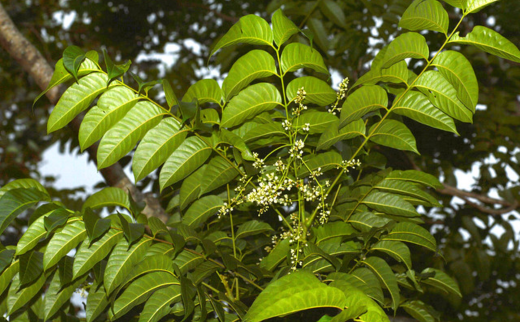The Toon/ Red Cedar/ Cedrela toona Roxb./ Toona ciliata – Ayurvedic Uses & Benefits
Abstract
Toona ciliata M. Roem, formerly known as Cedrella toona Roxb., is a significant medicinal plant belonging to the Meliaceae family. It is commonly referred to as Tooni in Sanskrit and Red Cedar in English. It holds an important place in traditional medicine. The plant is traditionally used for its antileprotic, bitter tonic, and anthelmintic properties. It has been employed in the prevention and treatment of various health conditions. It is a deciduous tree recognised for its medicinal, ecological, and timber value. The plant is rich in tannins, flavonoids, and other bioactive compounds. Its wide range of biological actions makes it a valuable species in herbal pharmacology.

Introduction
The Toon is commonly referred to as the Indian Cedar or Red Cedar. Cedrela toona is a fast-growing tree known for its reddish timber and numerous healing properties. It has been traditionally used in Ayurveda and other folk medicine systems for its astringent, antileprotic, and aphrodisiac properties. Both the bark and leaves hold medicinal significance and are used in various home remedies. This tree is not only a natural remedy but also ecologically important due to its soil-enriching ability and timber utility. Its versatility makes it both a botanical and therapeutic asset. It belongs to the Meliaceae family and is widely distributed across South Asia, Southeast Asia, and parts of Australia. This tree is notable for its therapeutic effects, especially in traditional Ayurvedic medicine.
Scientific Classification
- Kingdom: Plantae
- Clade: Tracheophytes
- Clade: Angiosperms
- Clade: Eudicots
- Order: Sapindales
- Family: Meliaceae
- Genus: Cedrela
- Species: Cedrela toona Roxb. (Syn. Toona ciliata)
Synonyms
- Tooni
- Tunnaka
- Aapin
- Tunika
- Kachaka
- Kuteraka
- Kantalaka
- Nandi Vriksha
- Nandaka
- Nandika
Vernacular names
- English Name: Toon, Red Cedar, Indian Mahogany
- Hindi Name: Toon, Tun, Tooni, Mahanim
- Bengali Name: Toongaacha, Tun
- Marathi Name: Tooni, Koorak, Kunant
- Gujarati Name: Tooni
- Tamil Name: Toonmaram
- Telugu Name: Nandi Vrikshamu, Nandichettu
- Kannada Name: Biligandhagiri, Tundu
- Manipuri Name: Tairel
- Malayalam Name: Vempu, Thunnam, Ikana, Arana
- Assamese Name: Poma Jatipoma
Habitat
Toona ciliata is native to and widely distributed across several Asian countries, including Bangladesh, Cambodia, China, India, Indonesia, Laos, Malaysia, Myanmar, Nepal, Pakistan, Papua New Guinea, the Philippines, Thailand, and Vietnam.
Morphology
Cedrela toona (Roxb.) is a medium to large-sized deciduous or evergreen tree that typically reaches a height of 25–35 meters. It features panicles measuring 20 to 40 cm in length and bears white petals approximately 5–6 mm long. The fruits are ellipsoid in shape, 10–20 mm long, and 6–8 mm in diameter, with winged seeds at both ends. The bark is scaly and ranges in colour from brown to grey. The tree has a petiole measuring 4–11 cm and petiolules that are 5–12 mm long. Leaves are 15–45 cm long, generally paripinnate, though a terminal leaflet may appear in young plants. Each compound leaf typically has 8–20 ovate to falcate leaflets, 4–15 cm long and 1.5–5 cm wide, with an acuminate apex and a distinctly asymmetrical base.
Classical categorisation
- According to Bhavaprakash Nighantu – Vatadi Varga
- According to Dhanvantari Nighantu – Chandanadi Varga
- According to Raj Nighantu – Chandanadi Varga
Ancient Verses
तूणी रक्तः कटुः पाके कषायो मधुरो लघुः ।
तिक्तो ग्राही हिमो वृष्यो व्रणकुष्ठास्त्रपित्तजित् ॥
(Bhavprakash Nighantu Vatadi varga 46)
According to the above shloka, Tooni has an astringent, sweet and bitter taste, is light in nature, reddish in colour, has cold potency, and its post-digestion effect is pungent. It has aphrodisiac and absorbent properties. It is effective in the management of bleeding disorders, wounds and skin problems. It balances Pitta dosha.
Ayurvedic properties
- Taste (Rasa) – Bitter (Tikta), Sweet (Madhur), astringent (Kashaya)
- Physical property (Guna) – Light (Laghu)
- Potency (Veerya) – Cold Potency (Sheet)
- Post-digestion effect (Vipaka) – Katu (Pungent)
- Effect on tridosha – Balance Pitta dosha
Therapeutic properties
- Astringent
- Menorrhagia (flowers)
- Spasmolytic (leaves)
- Hypoglycemic
- Antiprotozoal
- Antipyretic
- Anthelmintic
- Anti-inflammatory
- Hepatoprotective
- Antibacterial
- Antifungal
- Antidiarrheal
- Analgesic
- Antioxidant
- Tonic
- Wound healing
Systemic actions
External uses
The paste of its bark or its powder is effective in the management of wound healing.
Internal uses
- Digestive System: Its bark is really beneficial in the management of Chronic diarrhoea in children. It is also effective in the management of diarrhoea due to typhoid fever.
- Reproductive System: The hot infusion of flowers and bark is useful in the management of Menorrhagia. It contains aphrodisiac properties.
Chemical composition
- Cedrelone (tetranortriterpenoid)
- Toonacilin
- Terpenoids
- Phenylpropanoids
- Toonafolin (tetranortriterpenoid β-lactone)
- 6-Acetoxy toonacilin
- Toonacilid
- Geranyl geraniol
- δ-Cadinene
- Calamenene
- α-Calacorene
- Siderin (natural coumarin)
- Deoxycedrelone
- Sesquiterpenes
- Limonoids (Toonaciliatins)
- Cycloartene
- Stigmasterol
- Campesterol
- Apotirucallene
- 5-Methylcoumarin
- Tirucallene
- Catechin
- Proanthocyanidin
- Leucoanthocyanidin
Modern overview
Anti-inflammatory and Hemostatic Activities
In Cedrela toona (now known as Toona ciliata), the presence of triterpenoids plays a key role in its therapeutic effects, particularly in managing conditions like menorrhagia (excessive menstrual bleeding). These compounds exhibit anti-inflammatory action by inhibiting pathways such as NF-κB, which is responsible for promoting inflammation and vascular instability. By reducing inflammation, they help stabilise blood vessels and minimise bleeding. Additionally, certain triterpenoids in Toona ciliata possess hemostatic properties that support blood clot formation, further aiding in the control of heavy menstrual flow. This dual action of reducing inflammation and enhancing clotting makes Toona ciliata beneficial in addressing gynaecological conditions related to excessive bleeding.
Aphrodisiac activity
Cedrela toona (Toona ciliata) contains active compounds like triterpenoids and limonoids, which are believed to contribute to its aphrodisiac properties. These phytochemicals help enhance sexual health by modulating hormone levels, improving blood circulation, and reducing oxidative stress in reproductive tissues. Triterpenoids may stimulate the production of testosterone, thereby boosting libido and sexual vitality. Limonoids, known for their antioxidant and adaptogenic effects, help in reducing fatigue and improving overall reproductive function. Together, these compounds support better sexual performance, stamina, and hormonal balance. This makes Cedrela toona traditionally valuable in managing sexual weakness and promoting vitality.
Practical uses
- The paste of its bark or its powder is effective in the management of wound healing.
- The hot infusion of flowers and bark is useful in the management of Menorrhagia.
- Bark infusion or decoction is administered to children to treat diarrhoea resulting from indigestion.
- Dried leaf powder mixed with salt and water is used for managing diabetes, skin allergies, and wounds. It also functions as a blood purifier.
- Gum extracted from the bark is used in the treatment of fever.
- Flower decoction is employed in managing menstrual disorders and to stimulate menstrual flow, acting as a potent emmenagogue.
Part used
- Bark
- Flowers
- Leaves
Dosage
Infusion of 10-25 gm bark is taken with black pepper (Piper nigrum).
Conclusion
Cedrela toona, commonly known as Tooni, is a highly valued medicinal tree in traditional systems of medicine due to its diverse pharmacological properties. It is rich in bioactive compounds like triterpenoids and limonoids, which exhibit antimicrobial, anti-inflammatory, antioxidant, and aphrodisiac activities. Various parts of the plant, especially the bark, leaves, and flowers, are used in treating ailments such as diarrhoea, fever, menstrual disorders, skin allergies, and wounds. Its potent phytochemicals contribute to its therapeutic potential and justify its inclusion in herbal formulations. Scientific validation of its traditional uses supports its role in modern herbal medicine. Further research and standardisation are essential to fully explore its medicinal benefits and ensure safe usage.



